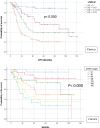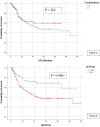Prognostic factors in gastric cancer patients: a 10-year mono-institutional experience
- PMID: 38362460
- PMCID: PMC10867173
- DOI: 10.3389/fsurg.2024.1321981
Prognostic factors in gastric cancer patients: a 10-year mono-institutional experience
Abstract
Introduction: Gastric cancer (GC) is one of the main causes of death from cancer globally. Long-term survival, especially in Western countries, remains dismal, with no significant improvements in recent years. Therefore, precise identification of clinical and pathological risk factors is crucial for prognosis, as it allows a better selection of patients suitable for oncologically radical treatments and contributes to longer survivals.
Methods: We devised a retrospective observational longitudinal study over 10 years of experience with GC patients operated with curative intent.
Results: Several factors were thoroughly investigated in a multivariate analysis to look for significance as independent risk factors for disease-free survival. Our results showed that only BMI, pTNM, and lymph node ratio expressed hazard ratios with implications for survival in our series of patients.
Discussion: Although limited by the retrospective nature of the study, this is one of the few cancer reports from Northern Italy showing results over 10 years, which may in our view, have an impact on decision-making processes for multidisciplinary teams dedicated to the care of gastric cancer patients.
Keywords: gastrectomy; gastric cancer; prognostic factors; risk factor; survival after surgery.
© 2024 De Ruvo, Fenocchi, Veronesi, Missori, Ricciardolo, Rossi, Sorrentino, Cautero, Serra and Gelmini.
Conflict of interest statement
The authors declare that the research was conducted in the absence of any commercial or financial relationships that could be construed as a potential conflict of interest.
Figures






References
LinkOut - more resources
Full Text Sources
Miscellaneous

